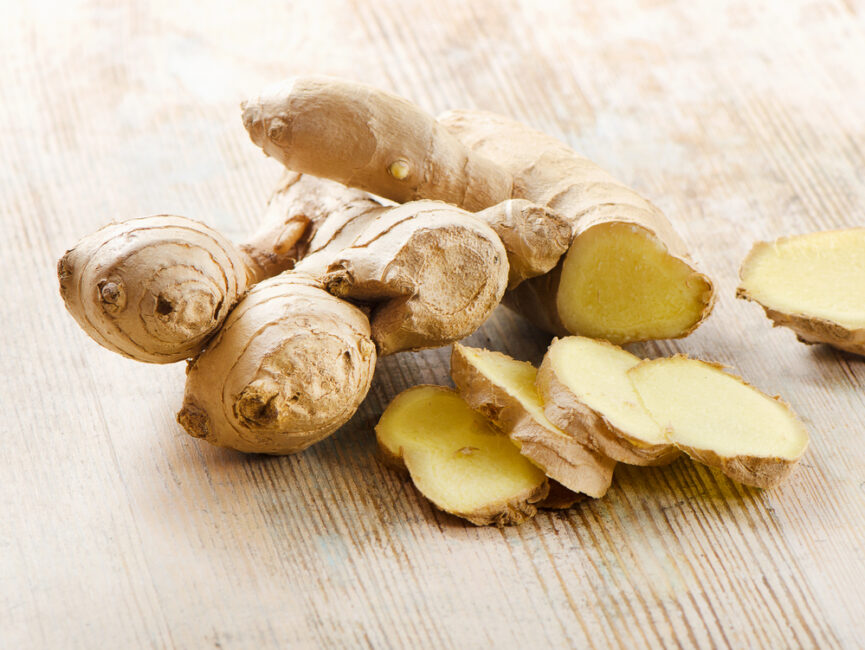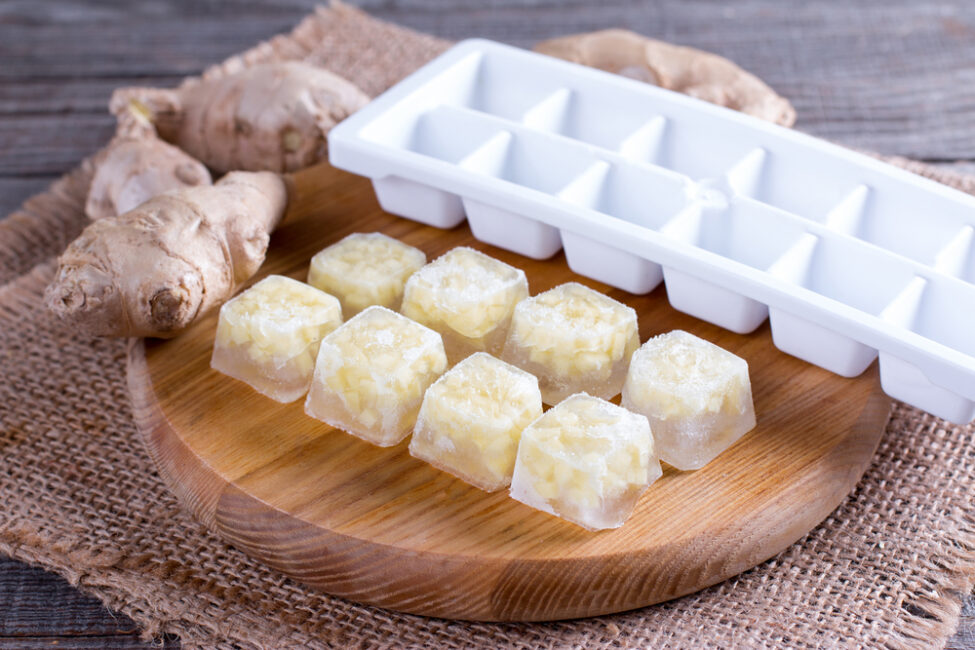This post may contain affiliate links. Please read our
disclosure policy
for more information.
Ginger is an incredibly multifaceted ingredient. You can use it in curries, stir-fries, salad dressings and even take advantage of it’s healing benefits when you are sick. Every now and again, I buy ginger with the intention of making one of those things and then… promptly forget.
Later on, I’ll be rifling through my fridge and find that well-intentioned ginger, looking forlorn and abandoned at the bottom of my crisper drawer. *cue sad violins*
I know I can’t be the only one. Ginger, with its spicy kick and anti-inflammatory benefits, is a (sometimes forgotten) kitchen staple for many of us. Whether you have some leftover or forgot the whole thing all together, the big question in this scenario is: How long does ginger last in the fridge? And what can we do to keep it fresh as long as possible?

The Quick Answer
If you’re looking for the quick scoop, here it is: Fresh ginger root can hang out comfortably in your fridge for about three weeks to a month. Of course, its longevity depends on a few key factors, including if it’s cut and how it’s stored. Stick around as we peel back the layers (see what I did there?) on how to keep your ginger fresh and full of zing.
Factors the Affect The Shelf Life of Ginger
Keeping ginger fresh is like walking a fine line. Too moist and it rots. Too dry and it degrades. Here are some things that can affect the fridge life of your ginger:
- To Cut or Not Cut To Cut: Whole pieces of unpeeled ginger root tend to last longer than pre-cut or peeled pieces.
- Storage: The way you prep and stash your ginger dramatically affects it’s life span in your fridge. Unpeeled and uncut ginger can last outside of the fridge for about a week. But, if you store it right in the fridge, it will last for up to a month. Read on to find out the best way to store it.
- Room Temperature Rules: Can’t you just leave ginger on the kitchen counter? Sure, ginger can hang out at room temperature for a bit, but it won’t last as long as it does in the fridge. We’re talking a week, tops, before it starts to lose its firmness and spicy personality.
- Sell-by / Use-by Dates: For store-bought ginger, these dates can be helpful but aren’t the final word. Fresh ginger doesn’t usually come with a sell-by date, so you’ll need to trust your senses. Look for firm roots with smooth skin, and avoid any that feel soft or show signs of mold.

Signs That Ginger Has Gone Bad
Figuring out if ginger has gone bad is less like the detective work of Inspector Clouseau and more like Inspector Gadget. (Go go gadget nose!!) That’s right. You too have all the gadgets to solve this puzzle already built in.
Trust Your Sniffer: Fresh ginger should smell zesty and peppery. If it smells off, sour, or has no aroma at all, that’s your first clue that it’s time to say goodbye.
Trust Your Touch: Fresh ginger boasts a firm, snappy texture. If it’s soft, mushy, or you can easily push your finger into it, it’s past its prime.
Trust Your Peepers: Look for any visible mold or discoloration. Ginger turning to the dark side often shows up with spots or a change in color.
While eating spoiled ginger is less likely to cause food poisoning, it can definitely lead to some digestive distress. If you find yourself eyeing your ginger skeptically, it’s best to just toss it. When in doubt, throw it out.

Tips on How to Maximize the Shelf Life of Ginger
Keeping your ginger fresh for as long as possible is about smart storage conditions. Here’s how to keep your ginger kickin’:
- Fridge It: Wrap unpeeled ginger root in a paper towel to combat excess moisture, then slip it into a resealable plastic bag and get out as much air as possible. Airtight containers also work, but they’re harder to get the excess air out of, which can affect freshness. After you wrap it, place it in your crisper. This method will keep your ginger cozy, dry, and away from any moisture that might speed up its decline.
- Keep It Whole: Resist the urge to chop or peel the entire root if you’re not using it all at once. Ginger keeps its freshness longer when stored whole. Just slice or peel the amount you need, then store the rest as described above.
- Freezing for Future Use: Ginger freezes remarkably well, and can extend its life for up to six months or more. It can also freeze in a variety of ways.
- Whole: Place a whole piece of ginger in a freezer bag, squeeze out all the air, and stick it in the freezer. When you need a piece, peel a section off and grate as you go. No need to thaw!
- Diced or Grated: For the best results, peel the ginger, then dice or grate and place them in to ice cube trays. Once frozen, transfer them to a freezer-safe bag or container. This method makes it easy to grab just the amount you need for cooking or brewing up some ginger tea.
- Ginger Paste: Scoop ginger paste into a silicone ice cube tray. Once frozen, transfer the “cubes” into a Ziploc bag and place back in the freezer.
- Safe Thawing: If you’ve frozen a large piece of ginger and need to thaw it, just leave it in the refrigerator overnight. For quicker thawing, you can leave it out at room temperature for a few hours. But for most needs, like cooking, you actually won’t need to thaw it at all.
- Label Like a Pro: When freezing ginger, remember to label the bag or container with the date, and make sure to use it within 6 months of freezing.
Creative Ways to Use Up Your Ginger
Got a knob of ginger lingering in your fridge? Before it crosses over to The Great Ginger Beyond, let’s talk about giving it its final encore. If your ginger is on the brink but not yet a candidate for the compost bin, consider these flavorful send-offs:
- Ginger Tea: Simmer thin slices of ginger in boiling water to make a soothing tea.
- Ginger Powder: Dry out small pieces of ginger in your oven (on a baking sheet and at a low setting) or use a food dehydrator if you have one, then grind them into a fine powder in a food processor. Viola! You have your very own homemade ginger powder!
- Ginger Paste: Blend ginger with a small portion of oil or water to create a paste.

FAQs
Is it a good idea to store ginger in a brown paper bag?
Stashing whole ginger in a brown paper bag is also a good option if you’re looking to store in your fridge’s vegetable drawer. The bag acts as a breathable home that helps absorb excess moisture. Just make sure to keep the bag in a cooler spot and away from direct sunlight.
Can I make ginger juice for later use, and how should I store it?
Ginger juice is like liquid gold for your health. It’s packed with a number of health benefits and, of course, that signature spicy flavor that can add a zesty kick to dishes and drinks. Since ginger is so potent, I recommend juicing your ginger, and storing it in small batches. For the fridge, just store it in an airtight container, and for a longer shelf life, freeze it in ice-cube trays. Frozen ginger juice cubes are great for smoothies AND cooking.
What’s the easiest way to peel ginger, and does it affect its shelf life?
The easiest way to peel ginger is to scrape its skin off with the edge of a spoon. However, peeling ginger can expose it to more air, which can accelerate moisture loss. Store peeled ginger in a resealable bag or airtight container in the fridge or freezer to slow degradation.
How can I tell if frozen ginger has freezer burn?
Freezing ginger is a great option to extend its life, but that doesn’t mean it’s immune to freezer burn. Look out for ice crystals, and a dry, leathery texture. You might also notice a loss of ginger’s vibrant color. While freezer burn doesn’t make the ginger unsafe to eat, it can certainly diminish its flavor and potency. To avoid this, make sure to wrap your ginger tightly, so you can minimize its exposure to air before you put it in the freezer.
We hope this comprehensive guide helps you to get the most out of your ginger.
Got a good ginger tip? Maybe a secret family recipe for the perfect ginger cake? We’d love to hear it! Share your thoughts and favorite ginger hacks in the comments below.
Here Are Some More Fridge Tips:
This post may contain affiliate links. Please read our
disclosure policy
for more information.
This post may contain affiliate links. Please read our
disclosure policy
for more information.
Ginger is an incredibly multifaceted ingredient. You can use it in curries, stir-fries, salad dressings and even take advantage of it’s healing benefits when you are sick. Every now and again, I buy ginger with the intention of making one of those things and then… promptly forget.
Later on, I’ll be rifling through my fridge and find that well-intentioned ginger, looking forlorn and abandoned at the bottom of my crisper drawer. *cue sad violins*
I know I can’t be the only one. Ginger, with its spicy kick and anti-inflammatory benefits, is a (sometimes forgotten) kitchen staple for many of us. Whether you have some leftover or forgot the whole thing all together, the big question in this scenario is: How long does ginger last in the fridge? And what can we do to keep it fresh as long as possible?

The Quick Answer
If you’re looking for the quick scoop, here it is: Fresh ginger root can hang out comfortably in your fridge for about three weeks to a month. Of course, its longevity depends on a few key factors, including if it’s cut and how it’s stored. Stick around as we peel back the layers (see what I did there?) on how to keep your ginger fresh and full of zing.
Factors the Affect The Shelf Life of Ginger
Keeping ginger fresh is like walking a fine line. Too moist and it rots. Too dry and it degrades. Here are some things that can affect the fridge life of your ginger:
- To Cut or Not Cut To Cut: Whole pieces of unpeeled ginger root tend to last longer than pre-cut or peeled pieces.
- Storage: The way you prep and stash your ginger dramatically affects it’s life span in your fridge. Unpeeled and uncut ginger can last outside of the fridge for about a week. But, if you store it right in the fridge, it will last for up to a month. Read on to find out the best way to store it.
- Room Temperature Rules: Can’t you just leave ginger on the kitchen counter? Sure, ginger can hang out at room temperature for a bit, but it won’t last as long as it does in the fridge. We’re talking a week, tops, before it starts to lose its firmness and spicy personality.
- Sell-by / Use-by Dates: For store-bought ginger, these dates can be helpful but aren’t the final word. Fresh ginger doesn’t usually come with a sell-by date, so you’ll need to trust your senses. Look for firm roots with smooth skin, and avoid any that feel soft or show signs of mold.

Signs That Ginger Has Gone Bad
Figuring out if ginger has gone bad is less like the detective work of Inspector Clouseau and more like Inspector Gadget. (Go go gadget nose!!) That’s right. You too have all the gadgets to solve this puzzle already built in.
Trust Your Sniffer: Fresh ginger should smell zesty and peppery. If it smells off, sour, or has no aroma at all, that’s your first clue that it’s time to say goodbye.
Trust Your Touch: Fresh ginger boasts a firm, snappy texture. If it’s soft, mushy, or you can easily push your finger into it, it’s past its prime.
Trust Your Peepers: Look for any visible mold or discoloration. Ginger turning to the dark side often shows up with spots or a change in color.
While eating spoiled ginger is less likely to cause food poisoning, it can definitely lead to some digestive distress. If you find yourself eyeing your ginger skeptically, it’s best to just toss it. When in doubt, throw it out.

Tips on How to Maximize the Shelf Life of Ginger
Keeping your ginger fresh for as long as possible is about smart storage conditions. Here’s how to keep your ginger kickin’:
- Fridge It: Wrap unpeeled ginger root in a paper towel to combat excess moisture, then slip it into a resealable plastic bag and get out as much air as possible. Airtight containers also work, but they’re harder to get the excess air out of, which can affect freshness. After you wrap it, place it in your crisper. This method will keep your ginger cozy, dry, and away from any moisture that might speed up its decline.
- Keep It Whole: Resist the urge to chop or peel the entire root if you’re not using it all at once. Ginger keeps its freshness longer when stored whole. Just slice or peel the amount you need, then store the rest as described above.
- Freezing for Future Use: Ginger freezes remarkably well, and can extend its life for up to six months or more. It can also freeze in a variety of ways.
- Whole: Place a whole piece of ginger in a freezer bag, squeeze out all the air, and stick it in the freezer. When you need a piece, peel a section off and grate as you go. No need to thaw!
- Diced or Grated: For the best results, peel the ginger, then dice or grate and place them in to ice cube trays. Once frozen, transfer them to a freezer-safe bag or container. This method makes it easy to grab just the amount you need for cooking or brewing up some ginger tea.
- Ginger Paste: Scoop ginger paste into a silicone ice cube tray. Once frozen, transfer the “cubes” into a Ziploc bag and place back in the freezer.
- Safe Thawing: If you’ve frozen a large piece of ginger and need to thaw it, just leave it in the refrigerator overnight. For quicker thawing, you can leave it out at room temperature for a few hours. But for most needs, like cooking, you actually won’t need to thaw it at all.
- Label Like a Pro: When freezing ginger, remember to label the bag or container with the date, and make sure to use it within 6 months of freezing.
Creative Ways to Use Up Your Ginger
Got a knob of ginger lingering in your fridge? Before it crosses over to The Great Ginger Beyond, let’s talk about giving it its final encore. If your ginger is on the brink but not yet a candidate for the compost bin, consider these flavorful send-offs:
- Ginger Tea: Simmer thin slices of ginger in boiling water to make a soothing tea.
- Ginger Powder: Dry out small pieces of ginger in your oven (on a baking sheet and at a low setting) or use a food dehydrator if you have one, then grind them into a fine powder in a food processor. Viola! You have your very own homemade ginger powder!
- Ginger Paste: Blend ginger with a small portion of oil or water to create a paste.

FAQs
Is it a good idea to store ginger in a brown paper bag?
Stashing whole ginger in a brown paper bag is also a good option if you’re looking to store in your fridge’s vegetable drawer. The bag acts as a breathable home that helps absorb excess moisture. Just make sure to keep the bag in a cooler spot and away from direct sunlight.
Can I make ginger juice for later use, and how should I store it?
Ginger juice is like liquid gold for your health. It’s packed with a number of health benefits and, of course, that signature spicy flavor that can add a zesty kick to dishes and drinks. Since ginger is so potent, I recommend juicing your ginger, and storing it in small batches. For the fridge, just store it in an airtight container, and for a longer shelf life, freeze it in ice-cube trays. Frozen ginger juice cubes are great for smoothies AND cooking.
What’s the easiest way to peel ginger, and does it affect its shelf life?
The easiest way to peel ginger is to scrape its skin off with the edge of a spoon. However, peeling ginger can expose it to more air, which can accelerate moisture loss. Store peeled ginger in a resealable bag or airtight container in the fridge or freezer to slow degradation.
How can I tell if frozen ginger has freezer burn?
Freezing ginger is a great option to extend its life, but that doesn’t mean it’s immune to freezer burn. Look out for ice crystals, and a dry, leathery texture. You might also notice a loss of ginger’s vibrant color. While freezer burn doesn’t make the ginger unsafe to eat, it can certainly diminish its flavor and potency. To avoid this, make sure to wrap your ginger tightly, so you can minimize its exposure to air before you put it in the freezer.
We hope this comprehensive guide helps you to get the most out of your ginger.
Got a good ginger tip? Maybe a secret family recipe for the perfect ginger cake? We’d love to hear it! Share your thoughts and favorite ginger hacks in the comments below.
Here Are Some More Fridge Tips:
This post may contain affiliate links. Please read our
disclosure policy
for more information.
 Did you try this recipe? Please leave a star rating in the recipe card below and leave a review in the comment section! I always appreciate your feedback and I know other readers do, too!
Did you try this recipe? Please leave a star rating in the recipe card below and leave a review in the comment section! I always appreciate your feedback and I know other readers do, too!
 Stay in touch with me in our Facebook group, on Pinterest or follow me on Instagram! Sign up for my email list, too where we chat all things recipes, tips, giveaways, and more!
Stay in touch with me in our Facebook group, on Pinterest or follow me on Instagram! Sign up for my email list, too where we chat all things recipes, tips, giveaways, and more!









